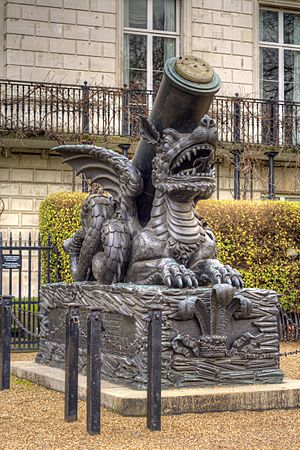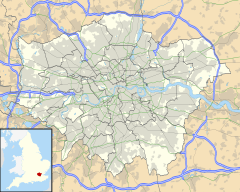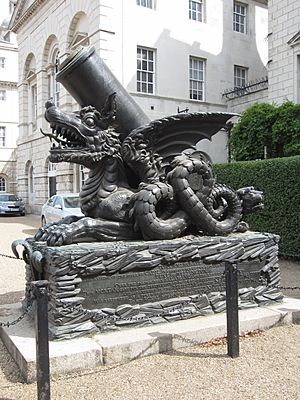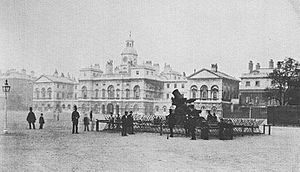Cádiz Memorial facts for kids

The memorial in 2015
|
|
| Coordinates | 51°30′15″N 0°07′38″W / 51.5042°N 0.1273°W |
|---|---|
| Location | London, SW1 United Kingdom |
| Material | Brass, bronze |
| Opening date | 1816 |
The Cádiz Memorial is a unique monument in London, United Kingdom. It is also known as the "Prince Regent's Bomb". This monument features an early 19th-century French mortar. A mortar is a type of cannon that fires shells at a high angle. This special mortar sits on a large brass sculpture of a mythical creature.
The memorial is located in Horse Guards Parade in Westminster. It was first shown to the public on August 12, 1816. Since 1987, it has been a Grade II listed building. This means it is an important historical structure. In the early 1800s, the monument was often featured in funny poems and cartoons. This was mainly because the word "bomb" sounded like "bum." People linked this to the large size of the Prince Regent, who was a well-known figure at the time.
Contents
What the Memorial Looks Like
The mortar sits on the back of a large brass sculpture. This sculpture shows a creature called Geryon. Some people wrongly called it a "Chinese dragon." Geryon is a monster from ancient stories, reimagined by the writer Dante Alighieri. This monster is linked to the Isle of Gades, where Cádiz is located. Its two tails twist around to support the mortar. At the back of the mortar, there is also a sculpture of a dog named Orthrus. The artists changed some parts of Geryon's classic look, like giving it wings instead of many heads.
The monster and mortar rest on a brass base. This base measures about 2.79 meters (9 feet 2 inches) by 1.37 meters (4 feet 6 inches). It looks like a rock where the monster has landed. The entire monument is about 3 meters (9 feet 10 inches) tall. It weighs a huge 16 tons!
On the north side of the base, there is an inscription in Latin. It talks about the French being defeated near Salamanca by Duke Wellington. It also mentions the lifting of the siege of Cádiz. The inscription says the Spanish gave this powerful mortar to the Prince Regent. He then ordered it to be placed and decorated in this spot.
On the south side, there is another inscription, written in English. It says:
To commemorate
the Raising of the Siege of Cadiz, in consequence of the
Glorious Victory obtained by the
Duke of Wellington
over the French at Salamanca, on the 22d July 1812:
This Mortar, cast for the destruction of that Great Port,
with Powers surpassing all others,
and abandoned by the Besiegers on their Retreat,
was presented as a token of respect and gratitude by the
Spanish Nation,
To his Royal Highness the Prince Regent.
This inscription explains that the mortar was given to the Prince Regent. It was a gift from the Spanish people. They wanted to show their thanks for the victory at Salamanca. This victory helped end the siege of Cádiz.
At the front of the base, you can see the Prince of Wales's feathers. This is a symbol of the Prince of Wales. At the back, it says, "Constructed in the Royal Carriage Department. Earl of Mulgrave, Master General – A.D. 1814." This tells us where and when it was made.
History of the Memorial
How it Started
This mortar was one of many huge weapons used by the French army. They used it during the two-year siege of Cádiz in Spain. The French army was led by Marshal Soult. The mortar was made in Seville in March 1811.
In 1812, the Duke of Wellington won a big battle at Battle of Salamanca. After this, the French army retreated. They left the mortar behind, making it unusable by damaging its firing hole. This mortar was designed to shoot shells over a very long distance, about 4.8 kilometers (3 miles). It could actually reach up to 5.6 kilometers (3.5 miles)!
Even though these mortars were meant to scare the people of Cádiz into giving up, they were not very effective. They were often inaccurate. Shells would fall short of the town or fly completely over it. Some did land in the city, but they caused very few injuries. One engineer saw the mortar fire a shot into a crowded town square. He said it didn't hurt a single person.
After the siege ended, the Spanish government gave one of these captured French mortars to Rear Admiral Arthur Kaye Legge. They asked for it to be placed in a Royal Park in London. This would celebrate the victory at Salamanca and the Duke of Wellington's achievements. The Prince Regent agreed. He asked the Earl of Mulgrave to get a special base for the mortar. It was then set up in Horse Guards Parade. The Royal Carriage Department in Woolwich created the detailed bronze base. The monument was revealed on the Prince Regent's 54th birthday. It was first placed on the south side of the parade ground. Later, it was moved to its current spot next to the Horse Guards building.
The Regent's Tremendous Thing
At that time, a common slang word for a cannon or mortar was a "bomb." Because of this, the Cádiz mortar quickly got the nickname "Regent's Bomb." This nickname became quite famous. People found it funny because the word "bomb" sounded like "bum." This made a humorous connection to the Prince Regent, who was known for his large size.
See also
 In Spanish: Monumento a Cádiz para niños
In Spanish: Monumento a Cádiz para niños




